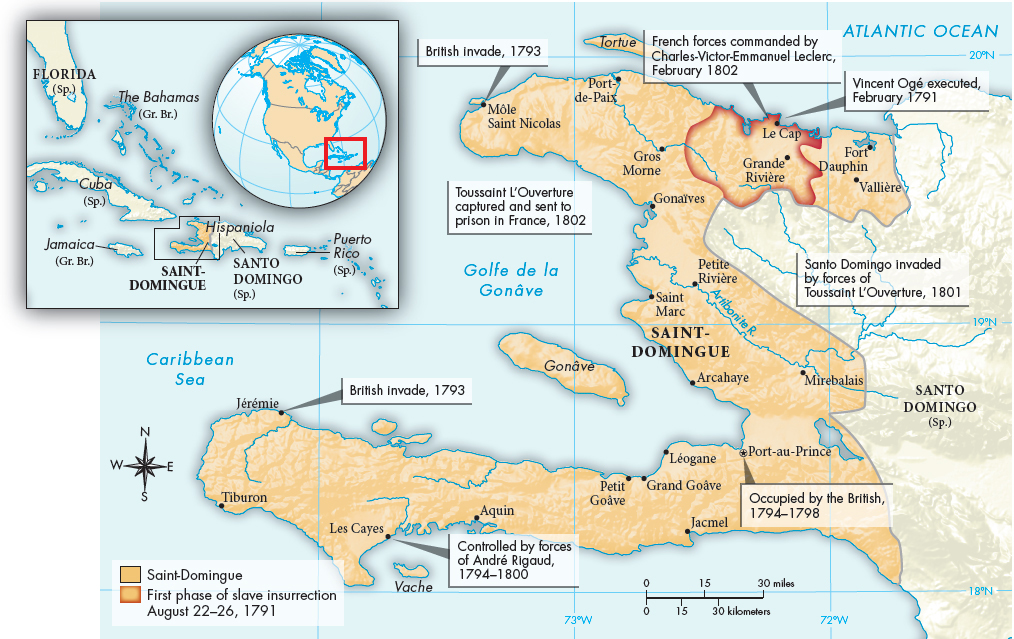A History of World Societies:
Printed Page 672
A History of World Societies Value
Edition: Printed Page 675
Chapter Chronology
The Outbreak of Revolt
Just as the sans-culottes helped push forward more radical reforms in France, the second stage of revolution in Saint-Domingue also resulted from decisive action from below. In August 1791 slaves, who had witnessed the confrontation between whites and free people of color for over a year, took events into their own hands. Groups of slaves held a series of nighttime meetings to plan a mass insurrection. In doing so, they drew on their own considerable military experience; the majority of slaves had been born in Africa, and many had served in the civil wars of the kingdom of Kongo and other conflicts before being taken into slavery.5 They also drew on a long tradition of slave resistance prior to 1791, which had ranged from work slowdowns, to running away, to taking part in African-derived religious rituals and dances known as vodou (or voodoo). According to some sources, the August 1791 pact to take up arms was sealed by such a voodoo ritual.
Revolts began on a few plantations on the night of August 22. Within a few days the uprising had swept much of the northern plain, creating a slave army estimated at around 2,000 individuals. By August 27 it was described by one observer as “10,000 strong, divided into 3 armies, of whom 700 or 800 are on horseback, and tolerably well-armed.”6 During the next month enslaved combatants attacked and destroyed hundreds of sugar and coffee plantations.
On April 4, 1792, as war loomed with the European states, the National Assembly issued a decree extending full citizenship rights, including the right to vote, to free people of color. As in France, voting rights and the ability to hold public office applied to men only. The Assembly hoped this measure would win the loyalty of free men of color and their aid in defeating the slave rebellion.
Warfare in Europe soon spread to Saint-Domingue (Map 22.3). Since the beginning of the slave insurrection, the Spanish colony of Santo Domingo, on the eastern side of the island of Hispaniola, had supported rebel slaves. In early 1793 the Spanish began to bring slave leaders and their soldiers into the Spanish army. Toussaint L’Ouverture (TOO-sahn LOO-vair-toor) (1743–1803), a freed slave who had joined the revolt, was named a Spanish officer. In September the British navy blockaded the colony, and invading British troops captured French territory on the island. For the Spanish and British, revolutionary chaos provided a tempting opportunity to capture a profitable colony.

MAP 22.3 The War of Haitian Independence, 1791–1804 Neighbored by the Spanish colony of Santo Domingo, Saint-Domingue was the most profitable European colony in the Caribbean. In 1791 slave revolts erupted in the north near Le Cap, which had once been the capital. In 1770 the French had transferred the capital to Port-au-Prince, which in 1804 became capital of the newly independent Haiti.
Desperate for forces to oppose France’s enemies, commissioners sent by the newly elected National Convention promised freedom to slaves who fought for France. By October 1793 the commissioners had abolished slavery throughout the colony. On February 4, 1794, the Convention ratified the abolition of slavery and extended it to all French territories, including the Caribbean colonies of Martinique and Guadeloupe.
The tide of battle began to turn when Toussaint L’Ouverture switched sides, bringing his military and political skills, along with four thousand well-trained soldiers, to support the French war effort. By 1796 the French had regained control of the colony, and L’Ouverture had emerged as a key military leader. (See “Individuals in Society: Toussaint L’Ouverture.”) In May 1796 he was named commander of the western province of Saint-Domingue (see Map 22.3). The increasingly conservative nature of the French government during the Thermidorian reaction, however, threatened to undo the gains made by former slaves and free people of color.
